Battery Modeling: Predicting the effects of aging on lithium-ion battery performance in electric vehicles

This blog reveals how Rimac Automobili uses the Modelon Electrification Library for accurate battery modeling. This proven model-based approach has made it simple to add aging dynamics to the electrical and thermal dynamics that was already validated for the other simulation purposes.
Designing high-performance battery systems
Rimac Automobili, known for their electric hypercars, is providing battery solutions for the most demanding projects in the automotive industry. Rimac uses a wide range of battery cells for different projects, which differ in chemistry and mechanical construction, and consequently their characteristics.
To develop electric vehicle powertrains that deliver the required vehicle range and optimal performance over time, it is essential for engineers to understand how the cell characteristics degrade as a result of use. It is essential to consider the complex processes of cell aging and “remaining useful life.” These must be considered for choosing a suitable cell, for designing battery modules of many cells, for optimizing control strategies, and for making estimates for car maintenance, etc.
Challenges of predicting aging of battery cells in the lab
To properly understand how the battery cell characteristics change with age, lab tests are performed with the cells in different operating conditions. Rimac utilizes inhouse lab facilities for evaluating the durability of different battery cells.
In the lab, cells are tested by cycling them according to different current profiles in the controlled environment of a climate chamber. During these tests, many variables are measured, such as voltage, current, capacity, as well as the temperature in the chamber and of the cell surfaces. During these tests, the cycling of the cells is periodically stopped, and characterization tests are performed to determine how the cell capacity and impedance has been changing.
These types of lab tests are very time consuming, a critical issue in the rapidly-developing field of battery technology. It is possible to accelerate these battery aging tests by increasing the current rates, operating temperatures, and discharge depth. But, it is still a major challenge to evaluate how the cells will age in the full range of operating conditions that they will be exposed to in actual vehicles.
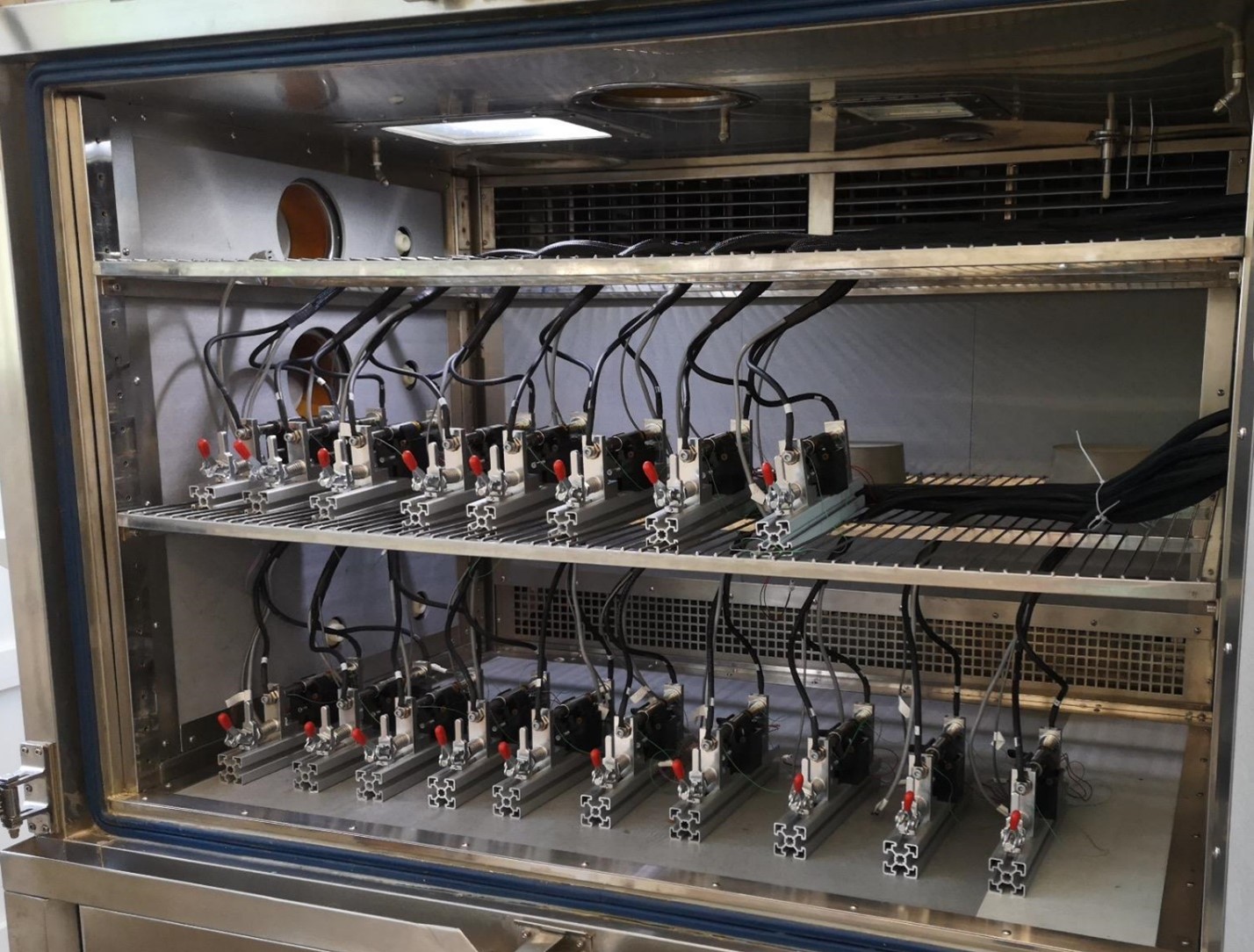
Predicting aging with simulations of dynamic battery models
To be able to predict the aging of batteries in a wider range of scenarios, Rimac has relied on Modelon’s system simulation software – using battery models from the Modelon Electrification Library for a number of applications. The modular architecture of these models made it simple to add aging dynamics to the electrical and thermal dynamics that was already validated for the other simulation purposes.
These models allow evaluating a large set of complex drive cycle inputs, in a way that would require too much time and resources to do in the lab. Lab test data is still required for parameterizing the characteristics of the battery cell aging models. Data has to be collected for different current rates, temperatures and state of charge (SOC). To make best use of the limited lab resources, the experiments are carefully designed to obtain a matrix of tests that maximizes the amount of aging information obtained for the model parameterization.
Equation based battery models
Battery models for aging can be separated into electrochemical and empirical models. The former describe the electrochemical degradation for a specific cell chemistry. However, the connection between what goes on at molecular-level to operation-level observation is still not considered sufficient. Rimac has therefore chosen to focus on empirical models for system simulations.
Initially, an evaluation was made of a semi-empirical model for LFP (LiFePO4) cells (also found in the Modelon Electrification Library). This model [Wang et al.] is based on a power law relationship which can be applied to LFP and other chemistries with similar aging mechanisms. A benefit of this equation based battery model is that it has a very few number of parameters that need to be fit to match the characteristics of the specific cell variant.
However, it turned out that it was not possible to achieve a sufficient fit to lab data for the cells and range of usage that was evaluated. Only one of the cell types matched the model characteristics well enough, and only for moderate aging. The plots (Figure 1) show three different cells characterized in lab tests, and the resulting battery model fitted to this data. It was concluded that this battery model may be good for some cell types and scenarios. Extended variants of this type of battery model could still prove useful. But it is currently not sufficient for accurately capturing the aging dynamics for all the different cells and scenarios that need to be simulated. A more generic approach was desired.
Figure 1: Equation based model fitted to measurements for three different cell types (NCA and LFP).
A sufficient fit was only achieved for one of the cell types over the evaluate range (80 % SOH)

Flexible table based battery models
The latest outcome of the collaboration between Rimac and Modelon is the introduction of new table based battery models for aging in the Modelon Electrification Library 1.5. These are fully empirical battery models that describe how the nominal cell characteristics (capacity and impedance) change over time. These battery models describe the change of these characteristics in the form of aging factors, parameterized as tabular functions of current and temperature.
In the simplest variant of the tabular models, these aging factors are defined as explicit functions of accumulated current throughput. This makes the parameterization fairly straight forward, as this is the typical form that data would be gathered in the lab tests. The battery models allow interpolation between several sets of data, for different C-rates and temperatures. A more general battery model is also available, where the gradients of the aging factors are parameterized for every operating point. This allows more detailed dynamics to be captured but requires more pre-processing of lab-data to parameterize the model.
Verification of battery aging models
The battery aging model was verified with the simulation experiment shown in Figure 2, replicating the boundary conditions (temperature and initial SOC) of the lab test. The Battery Cycler component from the Modelon Electrification Library was used for loading the cell according to the same power time profile as in the lab. In addition to the aging dynamics, the battery cell model included the electrical dynamics (SOC and impedance, with thermal dependencies) that had been verified in earlier experiments.
Figure 2: A verification experiment model, replicating the lab test
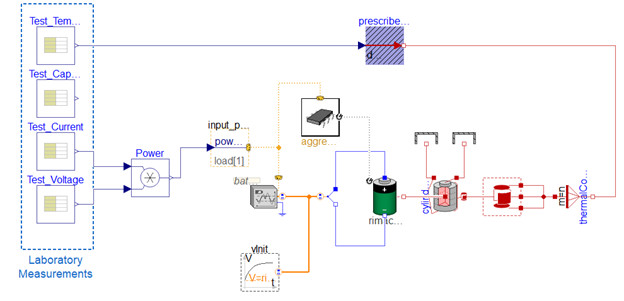
The plot shows the current, and finally the aging factor for charge capacity. The simulated capacity loss matches the lab data perfectly. After verifying that the battery model is accurate for the parameterization conditions, validation experiments are performed to evaluate the accuracy of the battery model for predicting aging in other data sets, where interpolation is done between the tabular data.
The plots in Figures 3 and 5 show the current and capacity loss for experiments where the parametrization is verified. The simulated capacity loss matches the lab data perfectly, even for highly dynamic current changes (Figure 5). After verifying that the battery model can accurately replicate the parametrized conditions, validation experiments are performed. This validation evaluates the accuracy of the model for predicting aging in other data sets, where interpolation is done between the tabular data (Figure 4).
Figure 3: Verification Test – Reproducing lab experiment with constant currents
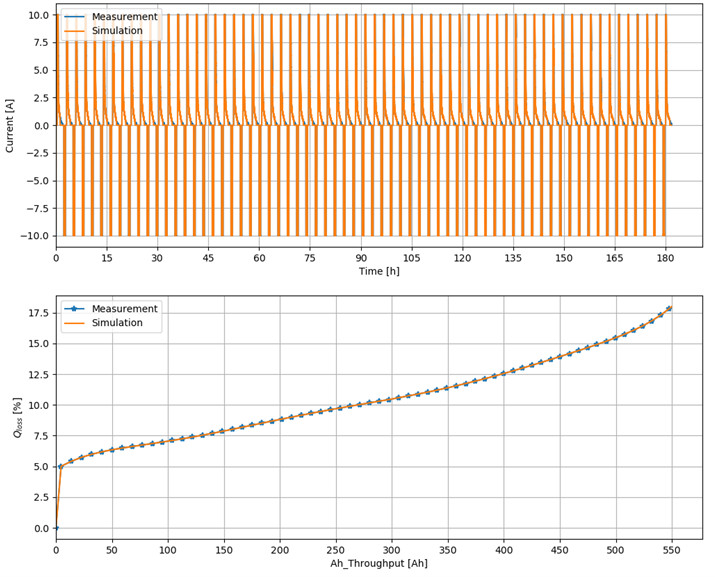
Figure 4: Validation Test – Interpolating between different C – Rates
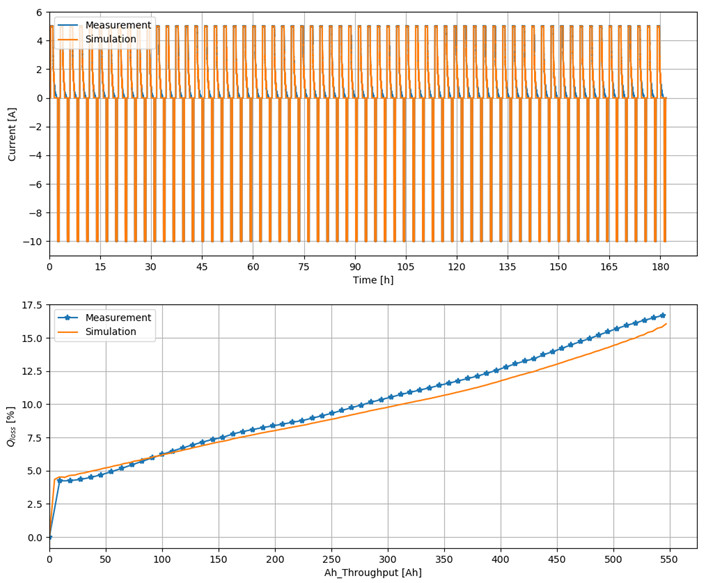
Figure 5: Verification Test – Reproducing lab experiment with dynamic current change
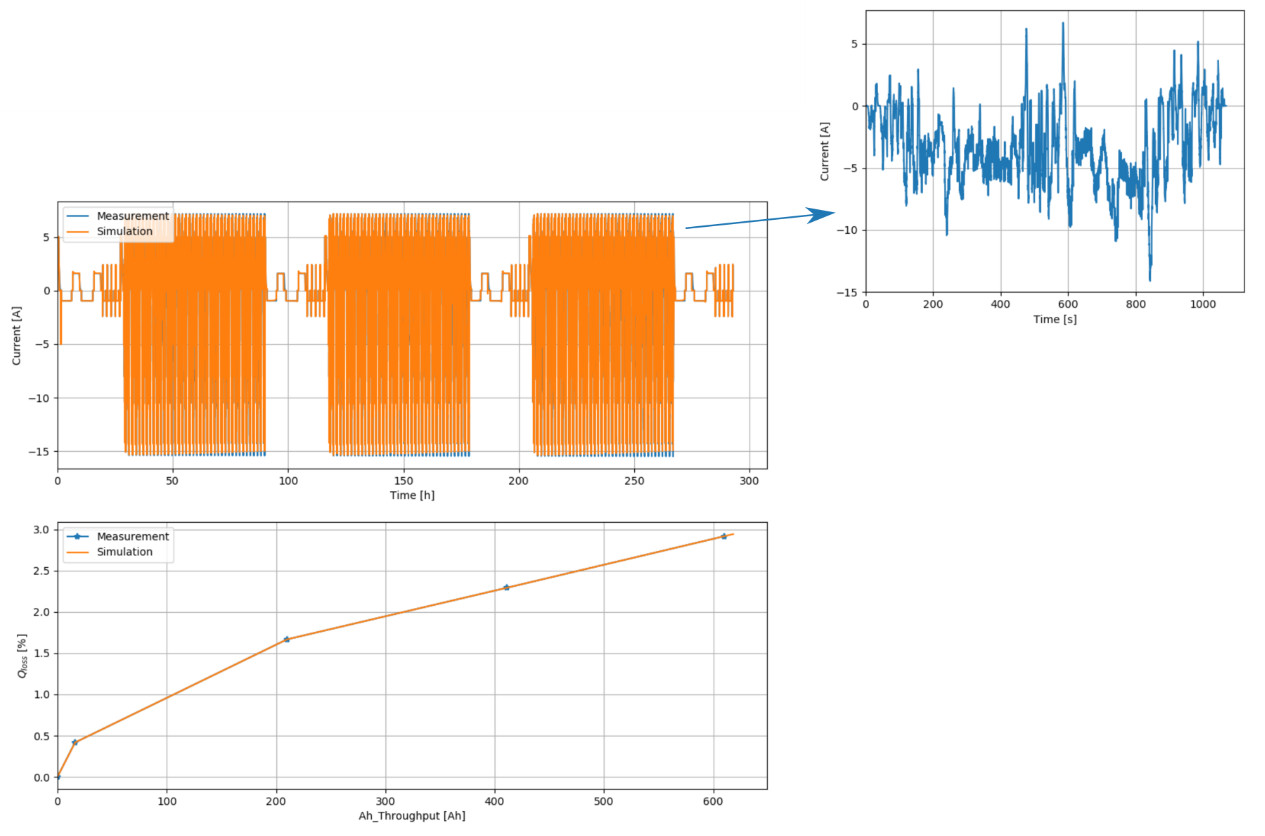
Conclusion
The introduction of flexible tabular aging battery models in the Modelon Electrification Library has made it possible for Rimac to accurately simulate the state of health for different battery cell types in a wide range of realistic electric vehicle driving cycles. Complementing the lab tests with these simulations is enabling better estimates of vehicle range and better evaluations of the match between a specific cell type and its intended operating conditions.
References
[Wang et al. 2011] Cycle-life model for graphite-LiFePO4 cells, Journal of Power Sources, Volume 196, Issue 8, 15 April 2011